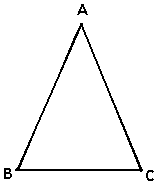How Albert Einstein Started His Career in Physics and Mathematics
In 1889, a family friend named Max Talmud (later: Talmey), a
medical student, introduced the ten-year-old Albert to key science and
philosophy texts, including Kant's Critique of Pure Reason and
Euclid's Elements (Einstein called it the "holy little geometry
book") From Euclid, Albert began to understand deductive reasoning
(integral to theoretical physics), and by the age of twelve, he
learned Euclidean geometry from a school booklet. He soon began to
investigate calculus.1
From
http://en.wikipedia.org/wiki/Albert_Einstein#_note-HarvChemAE
What are Euclid's Elements About?
Euclid's Elements is a mathematical work made up of 13 books
written by the Greek mathematician Euclid in circa 300BC. Each book
contains definitions, postulates (self-evident truths), propositions,
and theorems in the study of Geometry and Number Theory. The Elements
make up the oldest formal and deductive treatment of mathematics.
Reproducing the proofs of some of the propositions have been an
integral tool in training one's mind to think in a logical and
deductive manner from Euclid's time to the present.
An Example of a Deductive Proof From Euclid's Elements - Book I,
Proposition 6
If in a triangle two angles equal one another, then the sides
opposite the equal angles also equal one another.
The The way to prove this is to assume that the conclusion
is false the sides opposite the equal angles do not equal one
another. while assuming that the premise in a triangle two
angles equal one another is true and show that there is a
contradiction. In this way, we indirectly prove that the original
if-then statement is true. This method of proof, known as
Reductio ad Absurdum (or proof by contradiction) is widely used
in higher mathematics and science.
| Given a triangle ABC as shown below

We are assuming that angle ABC is equal to angle ACB yet sides
AB and AC are not equal. |
Justification This is our
assumption
|
| Since AB does not equal AC, then one side must be
greater. We let AB be greater. |
This is a
Common Notion of Euclid's Elements. |
| We can construct a triangle DBC where sides DB =
AC. 
|
This is justified by
Postulate 1 of Book 1 and
Proposition 3 of Book 1 which states that if two segments are
unequal, the longer may be "cut off" to the length of the shorter. |

We can now say that triangle ACB is equal to triangle DBC since
these triangles have a corresponding side, angle, and a side that
are equal. |
This is justified by
Proposition 4 of Book 1 which is commonly known in Geometry as
the Side-Angle-Side Theorem. |
| Since DB is constructed by cutting off
AB, DC < AB and also DB < AB by our original assumption. |
This is justified by a
Common Notion that states "the whole is greater than the
part". |
| We have equated a smaller triangle to a
larger triangle, which is a contradiction. This contradiction
proves If in a triangle two angles equal one another, then the
sides opposite the equal angles also equal one another. |
Proof by contradiction. |
This proof is a rewording of a proof give at
http://aleph0.clarku.edu/~djoyce/java/elements/bookI/propI6.html.
Are These Methods Still Taught In Schools Today?
Yes, Euclid's methods of proof, so valued by Albert Einstein and
countless scientists and mathematicians are still taught in high
school geometry courses. An
example of a 2-column proof is given here and a discussion of
high school geometry proofs is given here.
1 Dudley Herschbach, "Einstein as
a Student," Department of Chemistry and Chemical Biology, Harvard
University, Cambridge, MA, USA, page 3, web:
HarvardChem-Einstein-PDF: about Max Talmud visited on Thursdays
for 6 years.
|